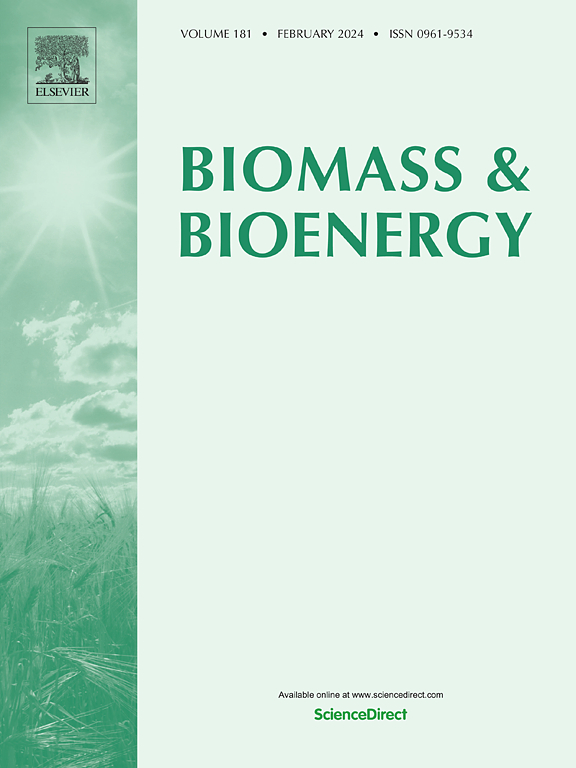Simultaneous alkali/air activation for hierarchical pore development in biochar and its use as catalyst carrier for formic acid dehydrogenation
IF 5.8
2区 生物学
Q1 AGRICULTURAL ENGINEERING
引用次数: 0
Abstract
Biochar provides an efficient strategy for making use of biomass residues, because it has shown to be a multifunctional material in energy and environmental applications. However, the underdeveloped porosity of biochar often makes it perform below potential. Herein, a novel activation method, namely simultaneous alkali/air activation, was tested for hierarchical pore development in biochar. The enhanced performance of the as-prepared porous carbon was evaluated by loading of palladium (Pd) for catalyzing formic acid dehydrogenation, a key reaction for the safe storage and transport of hydrogen. It was found that NaHCO3 was more effective than KOH on mesopore development in biochar when it was activated by air together. The carbon product possessing developed hierarchical pore structure (SABET = 1013 m2 g−1, SAmeso/SABET = 33.0 %) was obtained at 700 °C, using NaHCO3 as the alkali activator in a mixed air/nitrogen gas flow (30/70 by volume). The hierarchical pore structure of carbon made it a competent carrier of Pd catalyst, because the hierarchical pores not only enhanced the dispersion of Pd nanoparticles, but also served as the fast channels for the reactants to access the active sites intra catalyst particles. Therefore, the fast formic acid dehydrogenation (TOF = 156 h−1) was achieved when using the Pd catalyst loaded on such a hierarchically porous carbon.
碱/空气同步活化生物炭分层孔隙发育及其作为甲酸脱氢催化剂载体的应用
生物炭提供了一种有效的利用生物质残留物的策略,因为它在能源和环境应用中已被证明是一种多功能材料。然而,生物炭不发达的孔隙度往往使其性能低于潜力。本文采用碱/空气同步活化的方法,对生物炭的分层孔隙发育进行了实验研究。通过负载钯(Pd)催化甲酸脱氢,评价了制备的多孔碳的增强性能,甲酸脱氢是氢安全储存和运输的关键反应。结果表明,当NaHCO3与KOH一起被空气活化时,NaHCO3比KOH对生物炭中孔发育更有效。以NaHCO3为碱活化剂,在空气/氮气混合流量(体积比为30/70)下,在700℃条件下,得到了具有发达的分层孔隙结构(SABET = 1013 m2 g−1,SAmeso/SABET = 33 %)的碳产物。碳的层次化孔结构使其成为钯催化剂的有效载体,因为层次化孔不仅增强了钯纳米粒子的分散性,而且是反应物进入催化剂颗粒内活性位点的快速通道。因此,当使用负载在这种分层多孔碳上的Pd催化剂时,实现了快速甲酸脱氢(TOF = 156 h−1)。
本文章由计算机程序翻译,如有差异,请以英文原文为准。
求助全文
约1分钟内获得全文
求助全文
来源期刊

Biomass & Bioenergy
工程技术-能源与燃料
CiteScore
11.50
自引率
3.30%
发文量
258
审稿时长
60 days
期刊介绍:
Biomass & Bioenergy is an international journal publishing original research papers and short communications, review articles and case studies on biological resources, chemical and biological processes, and biomass products for new renewable sources of energy and materials.
The scope of the journal extends to the environmental, management and economic aspects of biomass and bioenergy.
Key areas covered by the journal:
• Biomass: sources, energy crop production processes, genetic improvements, composition. Please note that research on these biomass subjects must be linked directly to bioenergy generation.
• Biological Residues: residues/rests from agricultural production, forestry and plantations (palm, sugar etc), processing industries, and municipal sources (MSW). Papers on the use of biomass residues through innovative processes/technological novelty and/or consideration of feedstock/system sustainability (or unsustainability) are welcomed. However waste treatment processes and pollution control or mitigation which are only tangentially related to bioenergy are not in the scope of the journal, as they are more suited to publications in the environmental arena. Papers that describe conventional waste streams (ie well described in existing literature) that do not empirically address ''new'' added value from the process are not suitable for submission to the journal.
• Bioenergy Processes: fermentations, thermochemical conversions, liquid and gaseous fuels, and petrochemical substitutes
• Bioenergy Utilization: direct combustion, gasification, electricity production, chemical processes, and by-product remediation
• Biomass and the Environment: carbon cycle, the net energy efficiency of bioenergy systems, assessment of sustainability, and biodiversity issues.
 求助内容:
求助内容: 应助结果提醒方式:
应助结果提醒方式:


